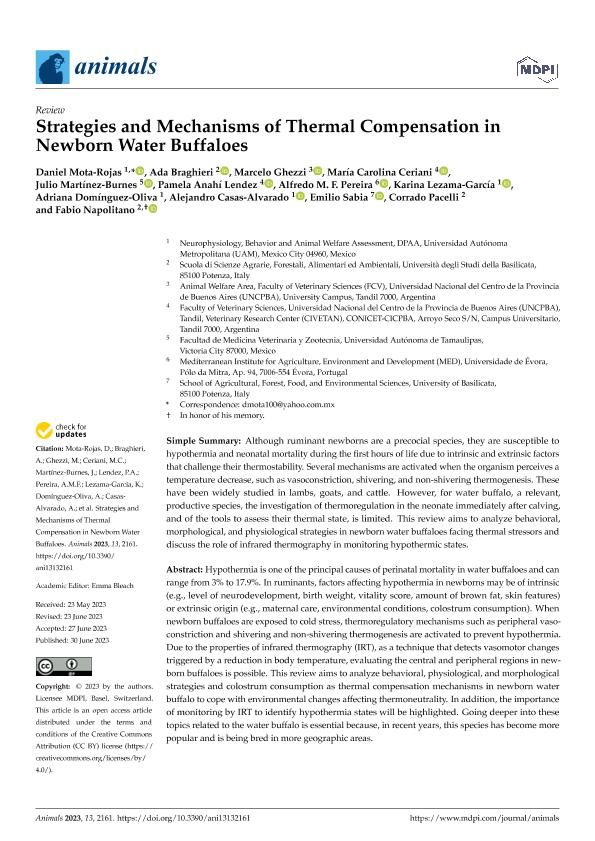Artículo
Strategies and mechanisms of thermal compensation in newborn water buffaloes
Mota Rojas, Daniel; Braghieri, Ada; Ghezzi, Marcelo Daniel; Ceriani, Maria Carolina ; Martínez Burnes, Julio; Lendez, Pamela Anahí
; Martínez Burnes, Julio; Lendez, Pamela Anahí ; Pereira, Alfredo M. F.; Lezama-García, Karina; Domínguez Oliva, Adriana; Casas-Alvarado, Alejandro; Sabia, Emilio; Pacelli, Corrado; Napolitano, Fabio
; Pereira, Alfredo M. F.; Lezama-García, Karina; Domínguez Oliva, Adriana; Casas-Alvarado, Alejandro; Sabia, Emilio; Pacelli, Corrado; Napolitano, Fabio
 ; Martínez Burnes, Julio; Lendez, Pamela Anahí
; Martínez Burnes, Julio; Lendez, Pamela Anahí ; Pereira, Alfredo M. F.; Lezama-García, Karina; Domínguez Oliva, Adriana; Casas-Alvarado, Alejandro; Sabia, Emilio; Pacelli, Corrado; Napolitano, Fabio
; Pereira, Alfredo M. F.; Lezama-García, Karina; Domínguez Oliva, Adriana; Casas-Alvarado, Alejandro; Sabia, Emilio; Pacelli, Corrado; Napolitano, Fabio
Fecha de publicación:
07/2023
Editorial:
Multidisciplinary Digital Publishing Institute
Revista:
Animals
ISSN:
2076-2615
Idioma:
Inglés
Tipo de recurso:
Artículo publicado
Clasificación temática:
Resumen
Hypothermia is one of the principal causes of perinatal mortality in water buffaloes and can range from 3% to 17.9%. In ruminants, factors affecting hypothermia in newborns may be of intrinsic (e.g., level of neurodevelopment, birth weight, vitality score, amount of brown fat, skin features) or extrinsic origin (e.g., maternal care, environmental conditions, colostrum consumption). When newborn buffaloes are exposed to cold stress, thermoregulatory mechanisms such as peripheral vasoconstriction and shivering and non-shivering thermogenesis are activated to prevent hypothermia. Due to the properties of infrared thermography (IRT), as a technique that detects vasomotor changes triggered by a reduction in body temperature, evaluating the central and peripheral regions in newborn buffaloes is possible. This review aims to analyze behavioral, physiological, and morphological strategies and colostrum consumption as thermal compensation mechanisms in newborn water buffalo to cope with environmental changes affecting thermoneutrality. In addition, the importance of monitoring by IRT to identify hypothermia states will be highlighted. Going deeper into these topics related to the water buffalo is essential because, in recent years, this species has become more popular and is being bred in more geographic areas.
Archivos asociados
Licencia
Identificadores
Colecciones
Articulos(CIVETAN)
Articulos de CENTRO DE INVESTIGACION VETERINARIA DE TANDIL
Articulos de CENTRO DE INVESTIGACION VETERINARIA DE TANDIL
Citación
Mota Rojas, Daniel; Braghieri, Ada; Ghezzi, Marcelo Daniel; Ceriani, Maria Carolina; Martínez Burnes, Julio; et al.; Strategies and mechanisms of thermal compensation in newborn water buffaloes; Multidisciplinary Digital Publishing Institute; Animals; 13; 13; 7-2023; 1-31
Compartir
Altmétricas



